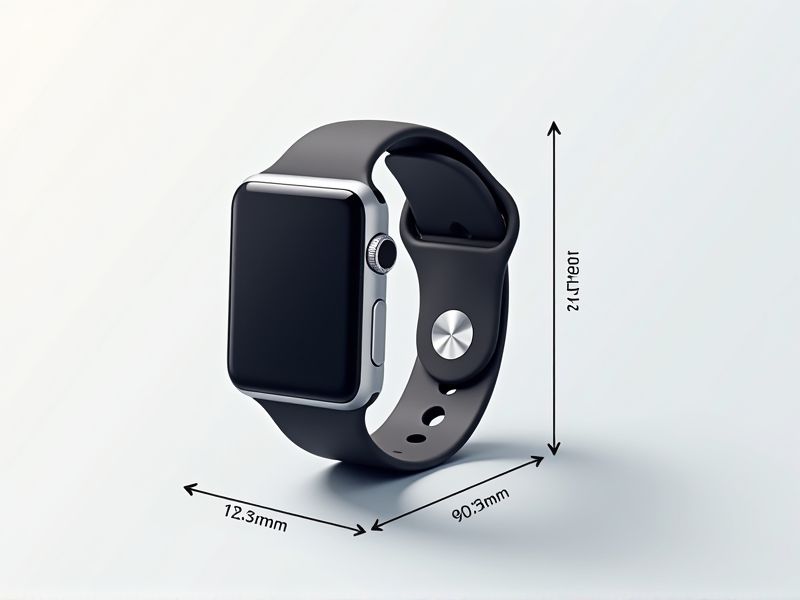
When shopping for a smartwatch, it's important to consider the standard dimensions to ensure a comfortable fit and optimal screen visibility. Most smartwatches typically have case diameters ranging from 38mm to 46mm, with thicknesses averaging around 10mm to 15mm. The width of the watch band is commonly between 20mm and 24mm, making it easy to find replacement bands if needed. By keeping these standard dimensions in mind, you'll be more likely to choose a smartwatch that matches both your wrist size and style preferences.
Display Size
The display size of a smartwatch plays a crucial role in user experience and functionality, with optimal sizes ranging from 1.2 to 1.5 inches diagonally. A larger display not only enhances visibility for notifications and apps but also allows for easier interaction, particularly for fitness tracking and navigation. For instance, smartwatches with AMOLED screens typically offer vibrant colors and deep contrasts, significantly improving readability in various lighting conditions. When selecting a smartwatch, consider that an ideal display size can greatly influence the comfort of daily wear and usability.
Screen Resolution
The screen resolution of smartwatches typically ranges from 200x200 pixels to over 320x320 pixels, providing sharp and vibrant visuals for user interactions. A higher resolution not only enhances the clarity of notifications and icons but also improves the readability of text in direct sunlight. For instance, models with AMOLED displays often showcase deeper blacks and more vivid colors compared to traditional LCDs. When choosing a smartwatch, consider how screen resolution impacts your overall user experience, especially during activities like fitness tracking or reading messages.
Case Diameter
The case diameter of smartwatches typically ranges from 34mm to 46mm, catering to various wrist sizes and styles. A smaller case, around 34mm to 40mm, is ideal for individuals who prefer a subtle, elegant look, while larger cases, from 42mm to 46mm, offer a bolder appearance and enhance visibility for users engaging with fitness tracking or notifications. The material composition of the case, often aluminum, stainless steel, or titanium, also significantly influences durability and weight, ensuring comfort during daily wear. When selecting a smartwatch, consider how the case diameter complements your personal style and enhances your usability experience.
Case Thickness
The average case thickness of smartwatches typically ranges from 10mm to 14mm. A thinner case, around 10mm, is often preferred for comfort and sleek design, while thicker cases above 14mm may provide additional features like enhanced battery life or more extensive sensors. Notable brands like Apple and Samsung have models that exemplify this trend, offering various thicknesses to cater to personal preference and functionality. Understanding case thickness can significantly influence your decision when selecting a smartwatch that balances style and performance.
Strap Width
Strap width is a crucial factor when choosing a smartwatch, typically ranging from 18mm to 24mm, affecting both comfort and style. A wider strap, around 22mm, offers enhanced stability on the wrist, making it suitable for active users. Conversely, a narrower strap, such as 20mm, may appeal to those seeking a sleek and lightweight design. Selecting the right strap width ensures optimal fit, allowing you to personalize your smartwatch experience while enjoying features like fitness tracking and notifications.
Weight
The optimal weight for smartwatches typically ranges from 30 to 50 grams, ensuring comfort for all-day wear. A lightweight design not only enhances user experience but also supports various activities, from workouts to daily tasks. Many manufacturers incorporate materials like aluminum and silicone to maintain durability while keeping the device light. Choosing a smartwatch within this weight range can significantly improve your overall satisfaction and usability.
Material Composition
The material composition of smartwatches significantly influences durability and user experience. Many high-end models feature stainless steel or titanium casings, providing robust resistance to scratches and corrosion. Additionally, Gorilla Glass or sapphire crystal screens enhance protection against impact damage, ensuring longevity under daily wear and tear. With advancements in materials, some brands now utilize environmentally-friendly options, appealing to conscious consumers seeking sustainable technology.
Wrist Circumference Compatibility
Smartwatches typically accommodate wrist circumferences ranging from 5.5 to 8.5 inches, allowing for a comfortable fit across various body types. When choosing a device, consider adjustable bands or interchangeable options that enhance compatibility and personalization. Some models incorporate features like moisture resistance and ergonomic designs, ensuring durability during diverse activities. For the best experience, select a smartwatch that aligns with your wrist size, ensuring optimal functionality and comfort.
Waterproof Rating
A smartwatch's waterproof rating is crucial, often indicated by the IP (Ingress Protection) code, with common ratings like IP68, which offers dust-tight protection and can withstand immersion in water beyond 1 meter. Many models guarantee functionality during activities like swimming or showering, allowing you to engage in water sports without fear of damage. For example, a smartwatch with a 5 ATM rating can typically handle pressures equivalent to a depth of 50 meters. Ensuring your device meets these standards is essential for durability and optimal performance in various environments.
Sensor Placement
The standard of smartwatch design places significant emphasis on sensor placement, with optimal locations typically found on the underside of the device for accurate biometrics. For instance, heart rate sensors utilize photoplethysmography technology, making contact with the skin essential for functionality and precision. Most modern smartwatches incorporate multiple sensors, including accelerometers and gyroscopes, to provide integrated fitness tracking and motion detection capabilities. Ensuring that these sensors are ideally positioned can enhance your overall user experience, resulting in more reliable health monitoring and data collection.
